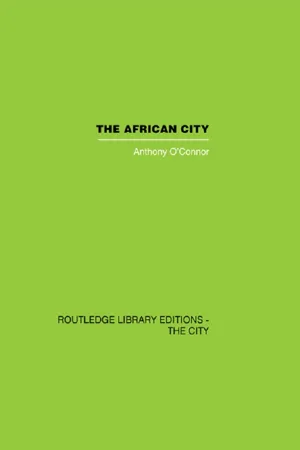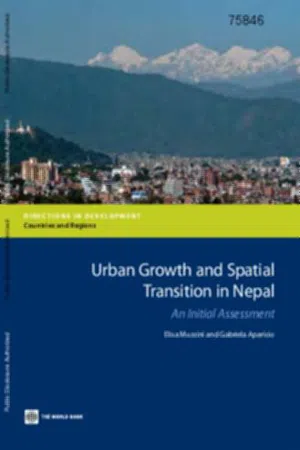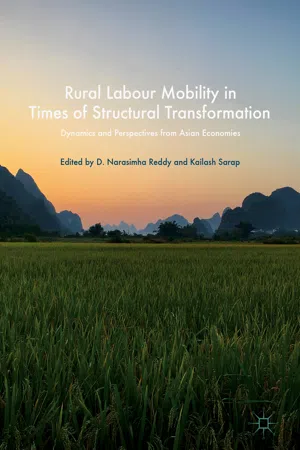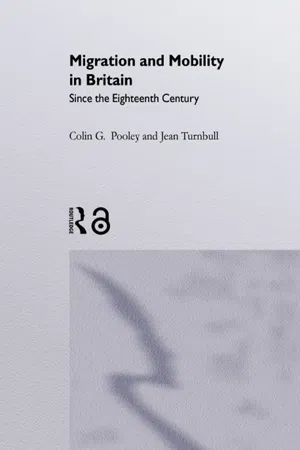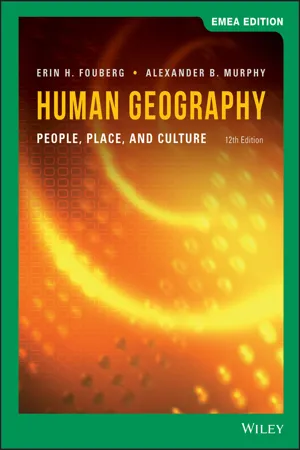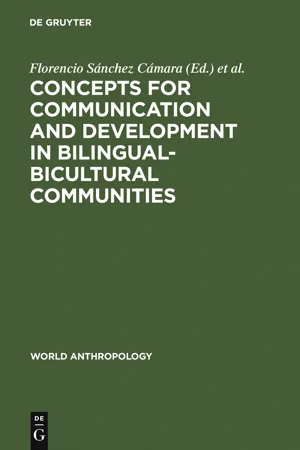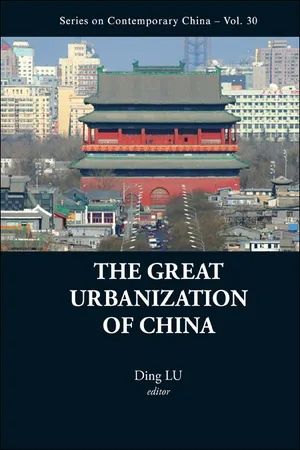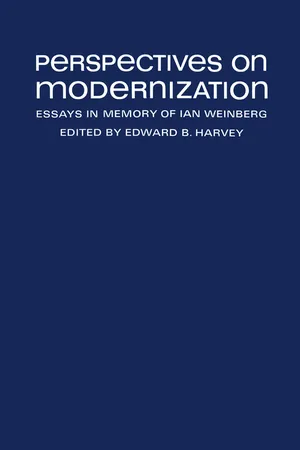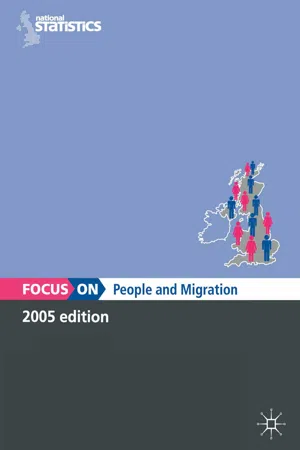Geography
Rural to Urban Migration
Rural to urban migration refers to the movement of people from rural areas to urban areas in search of better employment opportunities, improved living standards, and access to services. This demographic shift has significant impacts on both the areas of origin and destination, including changes in population distribution, urbanization, and strain on urban infrastructure and resources.
Written by Perlego with AI-assistance
Related key terms
1 of 5
11 Key excerpts on "Rural to Urban Migration"
- eBook - ePub
- Anthony O'Connor(Author)
- 2013(Publication Date)
- Routledge(Publisher)
3 Rural–urban migration
Until very recently migration was the chief contributor to total urban population growth in most parts of Africa: it remains everywhere the chief cause of a rising level of urbanization. Even today in most African cities there are far more migrant than local-born adults, and in relation to the size of the existing urban population the scale of such migration is greater than in any other part of the world. Net migration out of certain rural areas has actually reduced their population, as in parts of Zambia, although rural natural increase is too high, and the urban share of the total population too low, for this yet to be widespread.Population movements are constantly occurring throughout Africa, as they have always done (Prothero 1968, Gould and Prothero 1975, Clarke and Kosiński 1982). Prior to this century few were focused on cities, for even where these existed they grew mainly by natural increase. Today rural–to–urban movement is the dominant element in long-distance migration in most countries, though rural–rural local movements (for example, for marriage) may involve even more people.In examining rural–urban migration we are concerned with its extent, nature, causes and consequences, but all too little is known about each of these. Even the simple rate of net in-migration, either at present or in the recent past, is not known for any city. Subtracting a presumed rate of natural increase from total population growth provides only a crude indicator, even after allowing for births to recent migrants. Census data on birthplace are relevant for past movements, though influenced by such factors as women returning to the rural home area for childbirth. One might compare the size of each age group at the latest census with the size of the group ten years younger at a census ten years earlier, allowing for deaths: but truly comparable data are rarely available, age is often mis-reported, and even school terms and holidays may distort the figures. - eBook - PDF
Urban Growth and Spatial Transition in Nepal
An Initial Assessment
- Elisa Muzzini, Gabriela Aparicio(Authors)
- 2013(Publication Date)
- World Bank(Publisher)
42 The Spatial Transition Urban Growth and Spatial Transition in Nepal • http://dx.doi.org/10.1596/978-0-8213-9659-9 for males. Another push factor driving recent migration is the decadelong civil conflict. Although exact figures are not available, the civil conflict forced an estimated 1 million or more people to flee their homes, resulting in an escala- tion of migration (ADB 2010; Sengupta and Sharma 2006; Williams and Pradhan 2008). The number of migrants who move for economic reasons is increasing. Economic migration has gained importance as a livelihood strategy in recent years: pull factors—that is, the search for better employment and education opportunities—account for 43 percent of recent urban migration, compared with 32 percent of lifetime urban migration. Economic migration presents two distinct geographic patterns. First, those who move for economic reasons tend to settle in urban areas. Pull factors account for 32 percent of lifetime migration to urban areas but only 8 percent of lifetime migration to rural areas. Second, migrants who move for economic reasons are willing to travel longer distances than migrants pushed by social reasons. As many as 44 percent of nonlocal migrants to urban areas moved in search of jobs or for study and training pur- poses, compared with only 28 percent of local migrants to urban areas (see figure 2.7). More and more migrants are pulled to the Kathmandu Valley by economic opportunities. Large differences in economic opportunities across locations moti- vate people to migrate and to reap the benefits of living in a more prosperous place. - eBook - PDF
Rural Labour Mobility in Times of Structural Transformation
Dynamics and Perspectives from Asian Economies
- D. Narasimha Reddy, Kailash Sarap, D. Narasimha Reddy, Kailash Sarap(Authors)
- 2017(Publication Date)
- Palgrave Macmillan(Publisher)
PART II Rural: Urban Labour Mobility 183 © The Author(s) 2017 D.N. Reddy, K. Sarap (eds.), Rural Labour Mobility in Times of Structural Transformation, DOI 10.1007/978-981-10-5628-4_9 CHAPTER 9 The Changing Nature of Rurality: Reframing the Discourse on Migration and Commuting S. Chandrasekhar and Abhiroop Mukhopadhyay S. Chandrasekhar (*) Indira Gandhi Institute of Development Research, Mumbai, India A. Mukhopadhyay Indian Statistical Institute, New Delhi, India INTRODUCTION Where do urban boundaries end and rural areas begin? For administrative purposes, we know the answer. However, in many parts of India, the dis- tinction between rural and urban is increasingly getting blurred when viewed from space. Satellite imagery suggests no break in terms of built- up area when one reaches the city limits. At the same time, improvements in transport and communication infrastructure have increased the ease of movement of goods and people between rural and urban areas. All this has led to people questioning the dichotomous lens of an area being rural or urban. Instead, one prefers to focus on the catchphrase “rurban” and have a discussion centered on the degree of rurality. There is evidence to suggest that there has been a diversification of sources of income in rural India. As Gupta (2015) argues, “the earlier line that separated the farmer from the worker is slowly getting erased” (p. 38). The extent of rurality of different regions can be examined by many yardsticks, including the slope of the income gradient, the change 184 in the distribution of economic activity as distance from the city increases, or the source of income of rural households. Kundu et al. (2002) exam- ined how key indicators like literacy, per capita incomes, and consump- tion expenditure decline as the distance of the village from the city increases. They find that per capita incomes decline steeply “in the imme- diate vicinity of the urban centre” with the slope becoming less steep after 15 km. - Colin Pooley, Jean Turnbull(Authors)
- 2005(Publication Date)
- Routledge(Publisher)
This chapter examines a series of specific hypotheses about the extent, nature and characteristics of migration between places of different size. First, to what extent was Rural to Urban Migration, and movement from small towns to large towns, a dominant and consistent process in all British regions in the period after 1750? Second, were flows of migrants towards urban centres matched by coumterflows away from such places to other towns and rural areas? Third, to what extent did the selective characteristics of rural to urban migrants lead to the transfer of a younger population to towns and thus, it can be argued, the migration process effectively shifted rural fertility to towns and contributed to the high rates of natural increase in urban centres? Fourth, how important were migration experiences other than rural to urban moves, including processes of counter-urbanization, rural circulation and intra-urban residential mobility? By examining the totality of the migration experience over the 200 years from 1750, it should be possible to place assumptions about the significance of rural to urban moves in a wider context and resolve some of the apparent contradictions that emerge from earlier work.One of the problems associated with studying the significance of rural to urban movement lies in the arbitrary nature of rural and urban definitions. Studies of urbanization in nineteenth century Britain have adopted criteria of population size, sometimes backed up by evidence on population density and degree of nucleation. It is argued that such measures can, to some extent, be used as surrogates for, otherwise unavailable, data on urban functions (Law, 1967; Robson, 1973). However, there is no ready agreement about the size threshold that should be used to determine an urban settlement (Carter, 1995, pp. 10–17), and concepts of rurality are as elusive as definitions of urban settlements (Cloke and Edwards, 1986; Cloke, 1994). In this analysis implications about the degree of rurality or the extent of urban functions associated with particular settlements are avoided. Movement between settlements is assessed purely on the basis of population size, to examine the degree to which movement was mainly from small to larger places or vice-versa.- eBook - PDF
Human Geography
People, Place, and Culture
- Erin H. Fouberg, Alexander B. Murphy(Authors)
- 2020(Publication Date)
- Wiley(Publisher)
62 CHAPTER 3 Migration A patchwork of tarps, some dirty with the grit of the city and some new and still bright blue, covers the tent settlements of migrants. I wondered what rural village the migrants came from and how they chose this spot, tucked between high-rise developments in the middle of the city (Fig. 3.1). Migrants leave rural villages and move to cities, and in India, they keep a connection to their village by their choice of where to live. Through interviews with migrants living in tent settlements, Indian researchers have found that migrants who live in a tent set- tlement like this one tend to come from the same village and stay connected with their family and friends in the village. At the global scale, rural-to-urban migration represents one of the most dramatic shifts in human geography over the last cen- tury. In 1900, only 13 percent of people worldwide lived in cities; now more than 50 percent of people live in cities worldwide. Rapid migration from rural to urban helped Mumbai’s population dou- ble from 5.9 million in 1971 to 12.73 million in 2019. The greater urban area of Mumbai now has more than 22 million people. Informal settlements are found tucked between buildings in the central city like this one and also along railroad tracks in the eastern and western suburbs of Mumbai. Migrants living in slums and tent settlements have little security in terms of personal safety or control of land. Most lack access to drinkable water or sanitary sewers. The Census of India includes a survey of people living in slums in Mumbai. The vast majority of residents reported working in the service sector, including construction, or working in hutment factories located inside slums. Most are migrants who reported average salaries of less than $150 a month. This chapter explores why people migrate, whether by force or voluntarily. We discuss where people migrate, both within countries and across country borders, and how governments impact migration. - Florencio Sánchez Cámara, International Congress of Anthropological and Ethnological Sciences <9, Florencio Sánchez Cámara, International Congress of Anthropological and Ethnological Sciences <9(Authors)
- 2011(Publication Date)
- De Gruyter Mouton(Publisher)
Urban-Rural Migration as a Factor of Urban Growth and Social Disintegration in Mexico ALFONSO CORONA RENTERIA In this article I shall analyze some fundamental aspects of urban-rural relationships in the Mexican population. The nature of these relation-ships includes economic, social, and cultural factors. The object of the analysis is to show the role these relationships play both in the sociocul-tural integration process of Mexican society and in the urban regional development of the economy. In conclusion, I shall propose techniques to induce sociocultural change and development of the economy, in accor-dance with planned objectives in this field. The general concepts underlying this essay are as follows: (1) The concept of geo-economic space with regard to population settlements and the activities corresponding to them, and the relationships stemming from these activities. (2) The concept of a polarized region that depends on the existence of reciprocal but unequal and asymmetric relations between the city and the country. The city trades with the country and the less important localities that develop on its outskirts. But each locality depends more on the city than the city does on any of the localities in particular. They are, in fact, satellites of the city. The mechanics or networks of communications will be analyzed in terms of migration flows from the country to the city, and in terms of relations of domination between the city and its hinterland or polarized region. In both cases I will concentrate mainly on Mexico City, as it is the principal center of demographic attraction and the country's leading urban center. The best, most widely-known studies of marginal social development relate to immigrants to Mexico City. And the greatest contrasts in living standards, domination, and dependence occur in the relationships of the nation's capital with the tributary rural localities of the urban Mexican region.- eBook - PDF
China's Dilemma
Economic Growth, the Environment, and Climate Change
- Ligang Song, Wing Thye Woo, Ligang Song, Wing Thye Woo(Authors)
- 2009(Publication Date)
- Brookings Institution Press(Publisher)
110 China’s Dilemma 6 Rural–urban migrants A drvng force for growth Xiaodong Gong, Sherry Tao Kong, Shi Li and Xin Meng A spontaneous transfer of rural labour from agrculture to secondary and tertary ndustres accompanes economc growth n most countres. It s often beleved that ths movement s pushed partly by the ncrease of surplus labour n the agrcultural sector and, more mportantly, pulled by hgher returns to labour n urban manufacturng and servce ndustres. Through ths process, modern sectors wth hgh productvty expand and engage more labour to move nto modern sectors, leadng to an mprovement n overall productvty, whch n turn gves an mpetus to economc growth. The world has wtnessed Chna’s extraordnary pace of economc change n the past three decades. Underlyng Chna’s reforms are the economc ncen-tves and possbltes made avalable by a wde range of nsttutonal changes that stmulated rapd economc growth. Snce the 1990s, a most extraordnary phenomenon n Chna s the large-scale demographc movement nduced by the relaxaton of regulatons that restrcted labour moblty snce the early years of the communst regme. Whle the exact sze of the mgrant populaton s debatable, offical estmates suggest the number of rural mgrant workers n 2005 was about 126 mllon (NBS 2006)—amountng to the largest peace-tme movement of people n world hstory. 1 Ths massve reallocaton of rural labour to modern urban sectors s, at a mcro level, n response to the rapd rse n demand for labour n ctes where growth has been concentrated and because the rewards for labour are sgnfi-cantly hgher n urban than n rural areas. At a macro level, the reallocaton concdes wth the restructurng process of the economy from an essentally 111 Rural–urban migrants agraran socety to a predomnantly ndustral economy. At the begnnng of the reform perod, the agrcultural sector occuped more than 70 per cent of the total labour force and accounted for 28.2 per cent of gross domestc product (GDP). - eBook - PDF
- Ding Lu(Author)
- 2011(Publication Date)
- World Scientific(Publisher)
279 CHAPTER 11 Rural-Urban Migration and Urbanization in China* Kevin Honglin Zhang and Shunfeng Song Since 1978 China has experienced a rapid and unprecedented process of urbanization, created by the largest flow of rural-urban migration in his-tory in the world. This paper attempts (a) to assess the role of city-ward migration in China’s urbanization in 1978–1999 and (b) to empirically investigate the factors behind the migration boom with time-series and cross-section data. We find that (a) rural-urban migration made dominant contributions to the Chinese urban population growth; (b) while moving together with the Chinese economy, the causal link runs from economic growth to migration, not vice versa; (c) inter-province migrants were encouraged by the rural-urban income gap and discouraged by the geo-graphic distance to destinations; and (d) the number of intra-province migrants is positively related to the rural-urban income gap and urban population in that province. 1. Introduction As a result of the rapid economic growth in the two decades since the initiation of economic reforms in 1978, China has been experiencing rapid urbanization created by the largest flow of rural-urban migration in history in the world. According to the Chinese government, the urban population share in China rose significantly from 18 percent in 1978 to * Reprinted with the authors’ permission from China Economic Review , 14, pp. 386–400. 31 percent in 1999, and urban population rose by 222 million (SSB, 2000), compared with the entire US population of 280 million. The actual levels of urbanization and migrants could be higher, however, if the huge number of floating people is considered. What is striking in the Chinese experience is not only the size of the increase in its urbaniza-tion levels in such a short period of time, but also the magnitude of urban population growth. - eBook - PDF
Perspectives on Modernization
Essays in Memory of Ian Weinberg
- Edward Harvey(Author)
- 2019(Publication Date)
- University of Toronto Press(Publisher)
What occurred was a sort of halfway or partial movement. When the European immigrant moved from his home-land to the land that was now to become his home, a total commitment was involved. He could in no easy way turn back. The rural family, in contrast, made no clear com-mitment. In many cases, indeed, a shift from the occupation of farming to an urban occupation occurred well before there was any change in the family's place of residence. Employment, often of a part-time sort, may have been found first in the nearby town. The move of the family to the town followed, and then to other towns, and finally to the larger industrial centre where greater opportunities for employment were offered. But in all this moving of the rural family there occurred scarcely any break from the rural society. The rural family moved to the urban community without making itself Rural Migration and Urban Growth 103 a part of the urban society. It camped, so to speak, on the urban community's outer edges. Where urban growth was very great, it is true, the urban community reached out and ultimately engulfed those elements settled beyond its borders. The shack town was razed by the subdivision developer's bulldozer, and the small town and rural village, harbouring many of the families moving out of farm areas, were made part of the city. But these were developments that took place only after a long interval of time, and, indeed, if urban growth slowed down, never took place at all. By the very nature of their establishment, many of the communities forming outside the borders of the ur-ban community lay far beyond its reach. They tended to grow up in those areas least suitable for urban residential development, and once thus occupied they discouraged occupation in a different form. Therefore, as the urban community grew outwards, it tended to by-pass those residential developments which could not easily be incorpor-ated within it. - eBook - ePub
- Cecilia Tacoli(Author)
- 2018(Publication Date)
- Routledge(Publisher)
Current Economic and Social Commission for Asia and the Pacific (ESCAP) projections are that urbanization rates in South and south-west Asia will soon exceed other regions in Asia (Guest, 2003). This is already beginning to be reflected in the growing importance of rural–urban migration. While rural–rural migration 7 still accounted for roughly 62 per cent of all movements in 1999–2000 according to National Sample Survey data there has been a sharp increase in rural–urban migration recently (Srivastava and Bhattacharyya, 2003) as more young men travel to work in construction and urban services. For example, studies in areas of Bihar that have experienced a doubling of out-migration rates since the 1970s show that migration is now mainly to urban areas and not to the traditional destinations in irrigated Punjab where work availability has declined (Karan, 2003). In dry parts of Gujarat it was seen that urban incomes were so lucrative that not even government employment schemes such as the Jawahar Rozgar Yojana (JRY) and irrigation could reduce outmigration. Will migration in WSD areas continue to increase? Given the deteriorating situation in heavily populated rainfed areas of the country it is quite possible that migration rates will continue to increase despite efforts to create employment locally. In addition to the pushes and pulls mentioned previously, there could be other reasons for continuing migration including: • The additional employment created through watersheds is not keeping pace with population growth (and additional labour availability) - eBook - PDF
- NA NA(Author)
- 2016(Publication Date)
- Palgrave Macmillan(Publisher)
Initially, this draws in extra migrants from other parts of the UK, but as the recovery leads Fig ure6.10 Focus on People and Migration: 2005 to inflationary pressures in London, its residents take advantage of the higher value of their homes to move out. first mainly to the two adjacent regions but later on further out including to the North. Meanwhile, potenti al migrants from the North become increasingly deterred by London 's ri sing house prices and eventually by the narrowing of the job gap as the recovery spreads out across the UK. Urban-rural migration London's role as a dri ver of the UK's regional migration patterns can al so be associated with the process of urban out- migration. Starting in the 19th centu ry, the growth of suburbs around the cores of the cities l ed to the latter becoming home to an increasing proportion of the country's urban dwellers. later on, partly as a result of government policies aimed at reducing densit ies in the original cores of the larger cities, notably the post-war New and Expanded Towns programme, there was an absolute population l oss from many of these areas and faster growth in the suburbs and the separate cities and towns further away. Despite the official abandonment of the urban dispersa l programme in the 1970s, the urban-rural shift remains a major element of internal migration•• The scale, persi stence and pervasiveness of the urban exodus can be illustrated in a number of ways. First. Figure 6.10 shows net migration out of 'metropolitan England', defined as Greater London and the six former metropolitan counti es of Greater Manchester. Merseyside. South Yorkshire, Tyne and Wear, West Midlands and West Yorkshire. In all, since 1981 metropolitan England has lost 2.25 million people as a result of net migrati on exchanges with the rest of the UK, an average of 97,800 a year.
Index pages curate the most relevant extracts from our library of academic textbooks. They’ve been created using an in-house natural language model (NLM), each adding context and meaning to key research topics.
